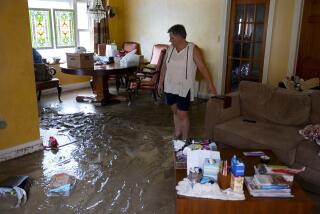Flooding hits small towns hardest
FOLEY, MO. — Flooding continued to rip apart small towns along the Mississippi River on Friday as urban areas were spared -- the flood highs in St. Louis were about 10 feet below expected near-record levels.
Some small communities were protected by levees that were not designed to hold back such high waters and couldn’t resist the river. Others had no protection at all and saw the Mississippi claim what it wanted.
Here in Lincoln County, where three levees were overrun Thursday and one on Friday, others were barely holding, with officials predicting three more could falter by the weekend. About 300 people were evacuated in this area north of St. Louis as residents watched floodwaters surge higher and higher.
“We’ve got water topping the levees all up and down” the county, said Kelly Hardcastle, the county’s director of emergency management. “It looks like a waterfall.”
Overnight rains made the misery worse, and more storms were expected this weekend. But they are not expected to add a significant amount of water to the swollen river.
With at least 25 levees breaking in recent days along either side of the river in Illinois, Iowa and Missouri, the flood of 2008 continues to threaten further havoc despite government forecasts that show the risk of more flooding is dropping.
Missouri Gov. Matt Blunt said Friday the high number of levee breaches shows that the federal government should survey the nation’s levees to find out what can be done to provide better flood protection. He said the biggest problem seems to be with dirt levees built privately and by communities to protect farmland.
“At some point people are going to get tired of this, and we need a coordinated review of the entire river shed,” Blunt said as he toured a sandbagging operation in Winfield. “It would minimize events like this.”
In Foley, Andy Watson, a roofer, is now living -- appropriately enough -- on his roof. For the last few days, Watson has kept a lonely vigil, watching for looters drawn by news accounts of communities that have cleared out in front of the cresting Mississippi.
“You know how thieves are,” Watson said during a tour of his makeshift living quarters about 10 feet above the ground. “Once the water starts going down, you guys aren’t going to be here, and the National Guard will go home. That’s when they come to get you.”
Like several of their neighbors, Watson and John Young were drawn to this town of less than 200 people when property values plummeted in the wake of the 1993 floods. It’s low ground, on the wrong side of the railroad tracks, but they figured it had been flood-proofed, in a sense, by the ’93 floods.
Four miles south, in Winfield, Sally Collier, 50, sat on the banks of a drainage ditch. A day earlier she watched in disbelief as the waters swelled across half a mile of farmland in less than 90 minutes, taking her bait shop. So far, her home has been spared.
More to Read
Sign up for Essential California
The most important California stories and recommendations in your inbox every morning.
You may occasionally receive promotional content from the Los Angeles Times.








